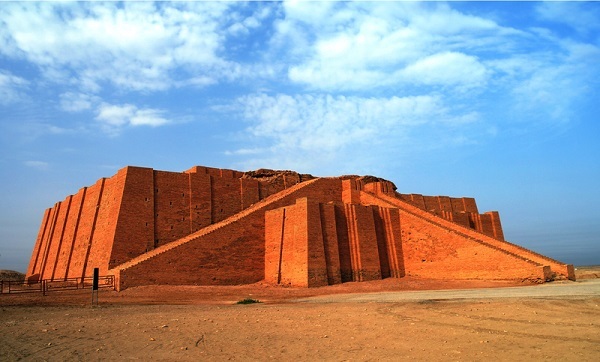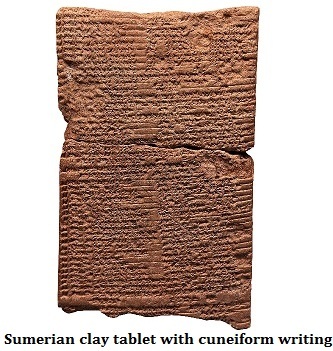

Sumerian art and architecture is the artistic and architectural style of the Sumerian civilization, which developed in ancient Mesopotamia (present-day Iraq) around 4000 BC. The Sumerians were among the first civilizations to develop a system of writing, and their art and architecture reflect their complex religious beliefs and social hierarchies.
Sumerian art and architecture were heavily influenced by their environment, featuring elements such as reeds, marsh plants, and animals that were found in the Tigris-Euphrates river valley. Some of the most notable examples of Sumerian art and architecture include sculptures, reliefs, seals, the ziggurat, the stepped pyramid, and the Temple of Enki.

Ziggurat in ancient Ur, Sumerian temple
Sumerian art is known for its highly stylized forms and figures, often featuring elongated bodies and exaggerated features. This stylization is thought to be a result of the Sumerian's desire to convey a sense of awe and reverence towards their gods.
Common motifs in Sumerian art include religious symbols, such as the crescent and star, as well as images of gods, goddesses, and kings. These motifs were believed to have protective powers and were often used to decorate temples and other religious structures.
Sumerian artists used a variety of mediums, including stone, metal, and clay, and their works include sculptures, reliefs, and seals. These works were often used to decorate the temples and palaces, and to commemorate important events.
Sumerian architecture is characterized by its use of mud brick and the development of the arch and the dome. The use of mud brick allowed for the construction of large, complex structures, and the arch and dome were important innovations that allowed for the construction of large, open spaces.
Sumerian cities were walled, and their religious and administrative buildings, such as temples and palaces, were often built on raised platforms to provide protection from floods.
Sumerian art and architecture was heavily influenced by their religious beliefs and social hierarchies. This can be seen in the use of religious symbols and motifs, as well as in the depiction of gods, goddesses, and kings in their art, and the placement and design of religious and administrative buildings in their architecture.
Sumerian art is known for its highly stylized forms and figures, often featuring elongated bodies and exaggerated features. This stylization is a unique feature of Sumerian art, and it is believed to be a way of expressing reverence and awe towards their gods and to make them easily recognizable.
Sumerian architecture is characterized by its use of mud brick and the development of the arch and the dome. The use of mud brick, which was readily available in the region, allowed for the construction of large and complex structures, while the arch and dome were important innovations that allowed for the construction of large, open spaces.
Sumerian cities were walled, and their religious and administrative buildings, such as temples and palaces, were often built on raised platforms to provide protection from floods.
Sumerian art and architecture also reflect the influence of their environment, featuring elements such as reeds, marsh plants, and animals that were found in the Tigris-Euphrates river valley.
This famous structure is a stepped pyramid that was built in the city of Ur around 2100 BCE. It served as a temple for the god of the city and as a center for religious and administrative activities.
This temple was dedicated to the god of wisdom and water and was built in the city of Eridu. It is considered as one of the oldest Sumerian temple and its design and decoration reflect the religious beliefs and values of the Sumerian civilization.
This is a limestone stele that dates back to around 2400 BCE. It was discovered at the site of the ancient city of Eannatum and depicts a scene of a battle between the city-state of Lagash and the neighboring city-state of Umma.
This is a bronze sculpture that dates back to around 2600 BCE and was found at the site of the ancient city of Tello. The sculpture depicts a lion-headed eagle with a human body, it is thought to be a representation of the god Ningirsu, who was associated with the power of the king and war.
In conclusion, Sumerian art and architecture are important aspects of ancient Mesopotamian civilization because they reflect its complex religious beliefs, social hierarchies, and the environment of the Tigris-Euphrates river valley. The stylized forms and figures, the use of mud brick, and the development of the arch and dome are the defining characteristics of this art and architecture.
Sumerian art and architecture not only give us an insight into the past but also serve as a reminder of the rich cultural heritage that has shaped the world we live in today. Overall, Sumerian art and architecture are a unique blend of form, function, and symbolism that continue to fascinate and inspire people to this day.
Q1. What was the role of Sumerian art and architecture in their society?
Ans. Sumerian art and architecture played a crucial role in their society, serving as a means of expressing religious beliefs and social hierarchies. Additionally, it also served as a way to showcase the wealth, power, and prestige of the ruling class.
Q2. How did Sumerian art and architecture evolve over time?
Ans. Sumerian art and architecture evolved over time, reflecting the changing religious beliefs, social hierarchies, and political power structures of the civilization. Additionally, as new building techniques and materials became available, Sumerian architecture also evolved to incorporate these developments.
Q3. How does Sumerian art and architecture compare to other ancient cultures?
Ans. Sumerian art and architecture have unique features and stylistic elements that set them apart from other ancient cultures. However, it shares some similarities with other ancient civilizations, such as the use of religious symbols and the depiction of gods, goddesses, and kings.